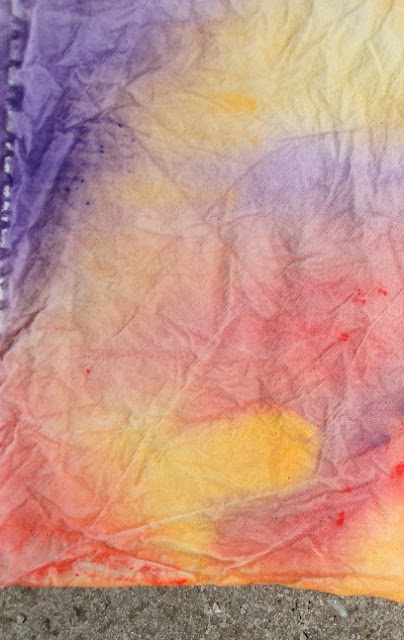Last week my friend, Jen and I decided to experiment with fabric painting. It is fascinating to see rich wet colors melt into the weave of cloth. Perhaps I can inspire you to try it too!
You will need:
- Acrylic paints in assorted colors
- Brushes and sponges
- Spray bottle filled with water (optional)
- Containers for water (We used some old yogurt containers.)
- Containers for mixing paints (Any old plastic container, preferably shallow, will work.)
- Fabric (We washed our fabric first and let it hang to dry in a crumpled fashion.)
- Plastic sheet to protect your work area
Now it's time to get started!
Squeeze out your paints and mix as desired. (Jen made a lovely aqua blue.)
Wet your fabric in the sink or using the spray bottle.
Lay the fabric on your protected surface.
 |
| Water-soaked medium weight canvas cloth |
Using a brush or a sponge, begin to work the color into the weave. Don’t be too shy about the amount of paint you use. Remember that the colors will fade as they dry.
 |
| Brush work |
 |
| Sponge work |
If you want a more watery look, spray more water on the cloth's surface.
 |
| Sprayed surface |
Once you have painted your fabric, lay it out to dry. (We laid our fabric out on the concrete walkway in the sun. It dried pretty quickly!)
 |
| Drying on the cement |
After your fabric has dried, you can press it with an iron to set the color. I used an old damp rag as a barrier between my iron – which my husband also uses for his work shirts! – and the painted cloth.
Wash in cold water (no soap needed) and hang to dry.
Here are some examples...
 |
| Pink and green swirls |
 |
| Color riot |
Other ideas:
- Start with a dry piece of cloth, work the paint into the cloth, and spray with water.
- Use a leaf or other object as a stencil.
- Try painting ribbon or lace. We painted some ribbon and then tied it twisties to create a tie dye effect.
What do you think? Want to give it a try?
To see more examples, check out Freestyle Fabric Painting Expressions.
To see more examples, check out Freestyle Fabric Painting Expressions.












